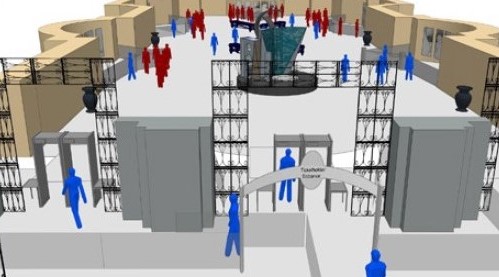How technology can support social distancing
Contents |
[edit] Introduction
Due to the impact of the COVID-19 pandemic, the world as we know it is changing. The bottom line is that buildings are not going to be able to reopen and operate safely without robust, post-pandemic planning for pedestrian movement.
Real people get confused and break rules. It is one thing to hang signs and tape lines and crosses to the floor, but will people stay in their boxes and comply with the rules? Will they have real fear of proximity?
Knowing how to manage your space as guidelines ease, or if the Government asks you to double down again overnight in the face of new waves of infection, is vital.
[edit] Designing with social distancing in mind
It will come as a relief to learn that raw materials for greater certainty, and the flexibility to keep up with a dynamic situation over the months, and possibly years, are all readily available. The likes of 2D and 3D CAD drawings for your building can be used to render a 3D model of the building which can be populated with realistic, intelligent agents whose behaviour is modelled by pedestrian movement software.
One example of technology that can be used to help map social distancing in a building is MassMotion. It is rather timely that the software world’s ubiquitous move towards subscription rather than outright licensing has come just as professionals across the built environment are grappling with the need to understand pedestrian behaviour in greater detail than ever before.
Its proximity modelling tests and visualises scenarios within computer models. Its native 3D design means that crucial potential pinch points (like stairs and elevators) are also modelled accurately and can be observed in animated visualisations.
Its sheer power means that new parameters can be entered into the model and a new simulation will run to test new ideas within minutes. Proximity modelling tools are used to show how close people are likely to get - and for how long - and highlight risk areas.
Oasys added proximity modelling to its pedestrian simulation software and explained, “What the team has done is to produce a new set of analytics that can be drawn from the software. We have also accelerated some experimental research to give customers the ability to test personal space preferences.”
[edit] Technology for existing buildings
Technology such as MassMotion will be crucial in designing and building future structures to ensure social distancing is far more achievable for the building’s occupants. How can other technological solutions help support social distancing measures in pre-existing buildings? After all, spatial awareness cannot be accurately relied upon.
Personnel distancing systems (known as PDS) are being trialled around the country. These proximity warning gadgets can be fastened to a person’s arm or belt, or in the case of construction sites, onto a hard hat. The technology can also be added to lanyards or wrist bands. Once the exclusion zone has been programmed, these tags will sound an alarm and vibrate if the wearer gets too close to another wearer.
This technology will be particularly useful in warehouses and shops, allowing staff in a highly mobile environment to focus on their jobs around the building and let the PDS alert them if social distancing measures are being breached.
[edit] The future of building management
Understanding and optimising how people use space is increasingly recognised by designers, but can it also inform smart environmental and energy management? As well as wearable smart sensors for people, there have been innovative smart sensors for buildings that detect the number of occupants in a space. This would suggest that there is a growing overlap here.
Pedestrian movement analysis could be a long-term addition to our toolbox, not just an interim response to the pandemic.
This article originally appeared in the Architectural Technology Journal (at) issue 135 published by CIAT in fall 2020. It was written by mediaworks on behalf of Oasys.
--CIAT
[edit] Related articles on Designing Buildings Wiki
Featured articles and news
RTPI leader to become new CIOB Chief Executive Officer
Dr Victoria Hills MRTPI, FICE to take over after Caroline Gumble’s departure.
Social and affordable housing, a long term plan for delivery
The “Delivering a Decade of Renewal for Social and Affordable Housing” strategy sets out future path.
A change to adoptive architecture
Effects of global weather warming on architectural detailing, material choice and human interaction.
The proposed publicly owned and backed subsidiary of Homes England, to facilitate new homes.
How big is the problem and what can we do to mitigate the effects?
Overheating guidance and tools for building designers
A number of cool guides to help with the heat.
The UK's Modern Industrial Strategy: A 10 year plan
Previous consultation criticism, current key elements and general support with some persisting reservations.
Building Safety Regulator reforms
New roles, new staff and a new fast track service pave the way for a single construction regulator.
Architectural Technologist CPDs and Communications
CIAT CPD… and how you can do it!
Cooling centres and cool spaces
Managing extreme heat in cities by directing the public to places for heat stress relief and water sources.
Winter gardens: A brief history and warm variations
Extending the season with glass in different forms and terms.
Restoring Great Yarmouth's Winter Gardens
Transforming one of the least sustainable constructions imaginable.
Construction Skills Mission Board launch sector drive
Newly formed government and industry collaboration set strategy for recruiting an additional 100,000 construction workers a year.
New Architects Code comes into effect in September 2025
ARB Architects Code of Conduct and Practice available with ongoing consultation regarding guidance.
Welsh Skills Body (Medr) launches ambitious plan
The new skills body brings together funding and regulation of tertiary education and research for the devolved nation.
Paul Gandy FCIOB announced as next CIOB President
Former Tilbury Douglas CEO takes helm.
UK Infrastructure: A 10 Year Strategy. In brief with reactions
With the National Infrastructure and Service Transformation Authority (NISTA).
























